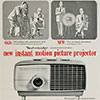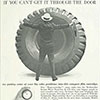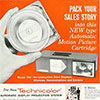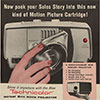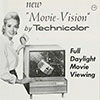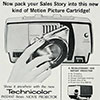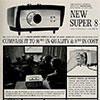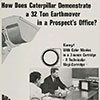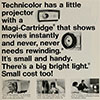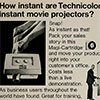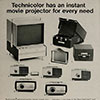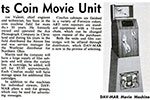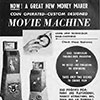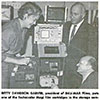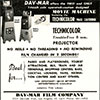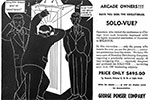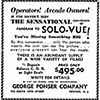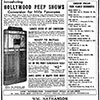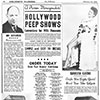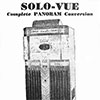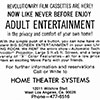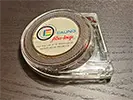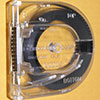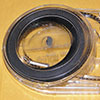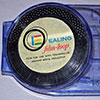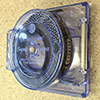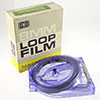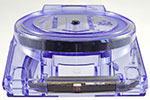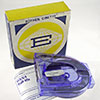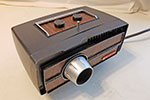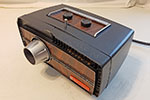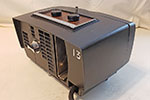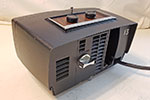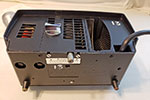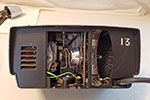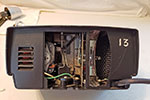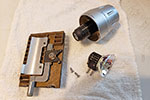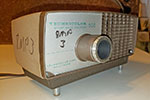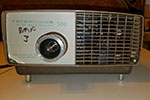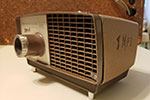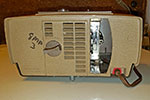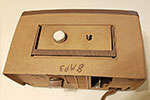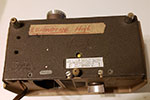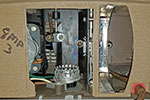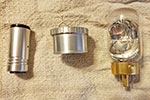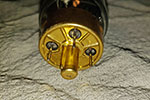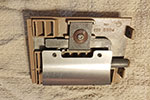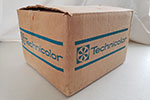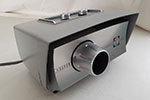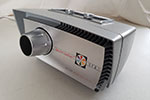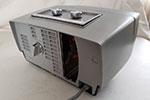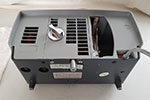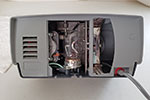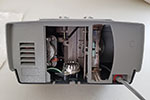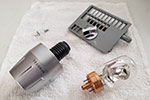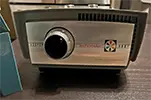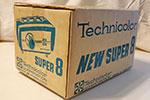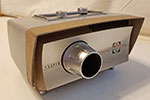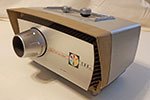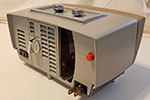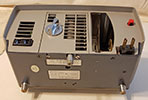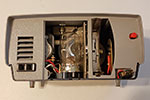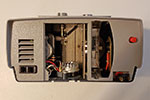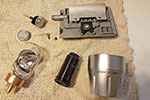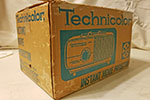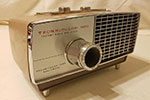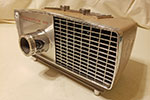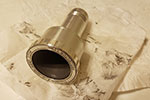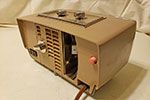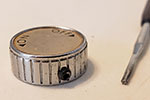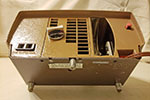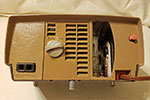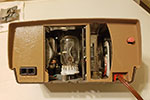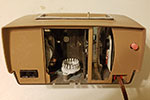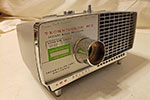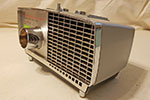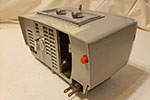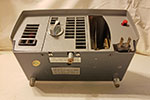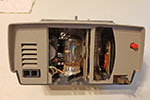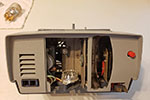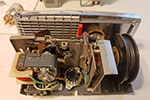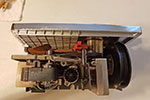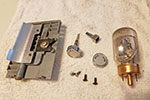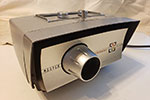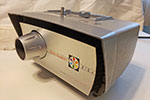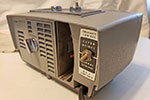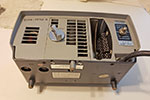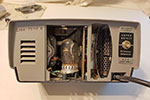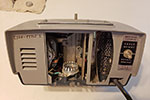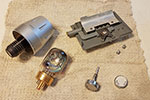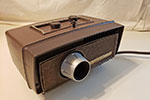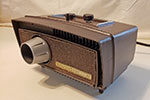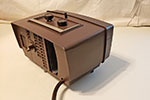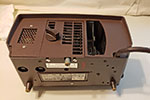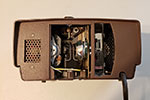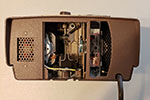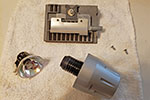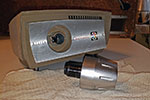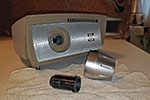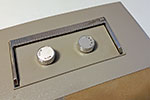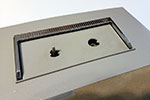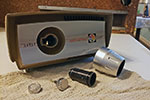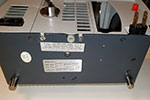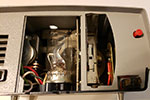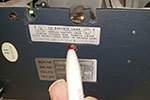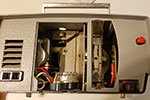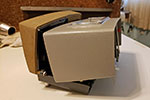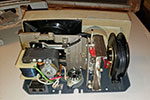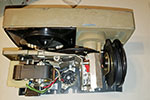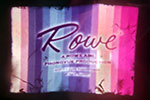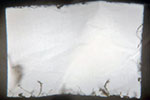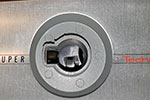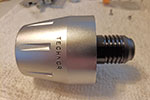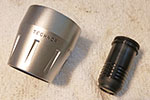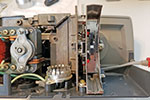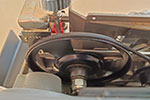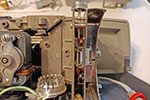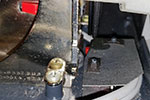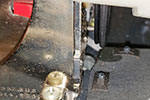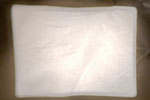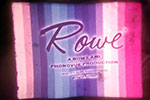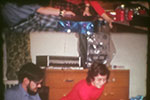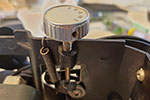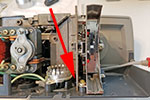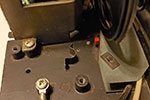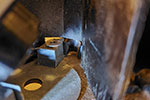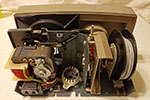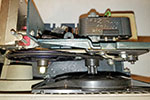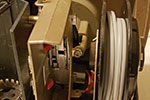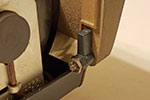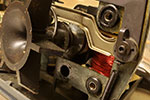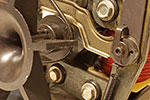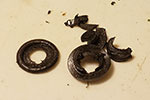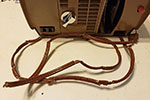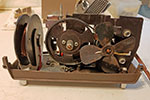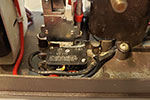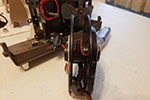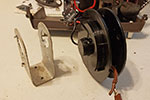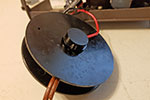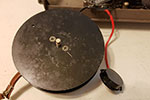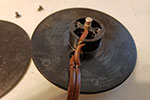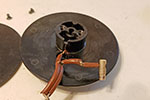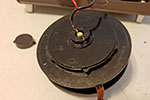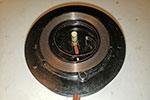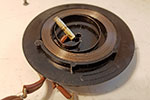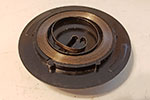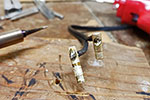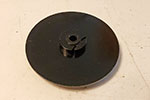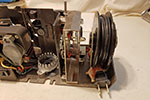Introduction
This page was started because of my interest in my 1971 AMI/Rowe MM5 Presidential jukebox and the PhonoVue I later bought for it. What this a PhonoVue does is play short, less than 3-minute long, loops of Super 8mm film to accompany the music from the jukebox.
Chan Gade in the AMI Classic Jukebox Collectors Facebook Group said that the optics in the PhonoVue were based on the Technicolor Super 510 film projector which had a 20-32mm zoom lens and played the 8mm Magi-cartridge film loops.
Until I can get the PhonoVue to work properly I needed a way to view the cartridges of film the unit uses. In August 2022, I started looking around for cheap Technicolor Instant Movie projectors. I chose this brand to look for first as it was the only ones I knew that could play the Magi-cartridges.
There were various other cartridge systems available such as the Bell & Howell Film Cassette, the Fairchild MoviePak,and the Videotronic Compact Super 8 Cartridge, none of which were compatible with each other, but this page concentrates on the Technicolor Super 8 silent Magi-cartridges. This is because I wanted a projector that could play the cartridges that the PhonoVue uses.
This is Important!
If you get hold of one of these projectors and a Magi-cartridge to use in it, when you first test the projector take the lamp out first. This is because if the film transport doesn't work and the lamp is on, it gets so hot you only have a couple of seconds to turn the projector off and get the cartridge out before the film starts melting.
The Magi-cartridge
Magi-cartridges were developed by Technicolor who applied for a patent in 1961 for both the cartridges and the projectors to play them. Magi-cartridges can hold around 50ft of film which gives a maximum play time of 4 minutes, but many are considerably shorter than this.
AMI Rowe made around 400 films for the PhonoVue while Technicolor had a catalog of 500 films for their projectors. There were countless other short films made by or for schools and colleges where these projectors and films were very popular. As these films were short, they had to be confined to a single subject and were often known as Single Concept Teaching Films. Schools could make their own films which could be sent to Technicolor who would mount them inside a Magi-cartridge and return them.
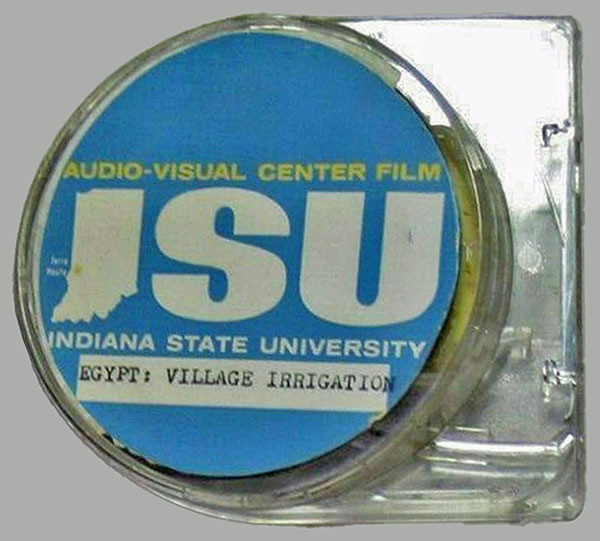
A standard 8 Magi-cartridge, Egypt: Village Irrigation, made by Indiana State University, where I happened to work before retiring.
This is made of clear plastic, has no ridge on the bottom edge, and has a rounded edge on the loop end of the cartridge, so this is a standard 8mm film Magi-cartridge.
The cartridges are robust, well-made and protect the film loop from most forms of damage. There are some disadvantages to them. The films were very short, no more than 4 minutes long. If someone wanted to make their own film they had to be inserted into the cartridge by Technicolor. There was a risk that the loops of film could rub against each other and be damaged, but that appears to have been a rare occurance.
Some companies can digitize the film loops, but the cartridges seem to be destroyed during the process as the film loop has to be cut out of the cartridge. In 2022, the average cost appears to be around $15 per cartridge for them to be digitized.
History
The March 1962 issue of Popular Science had a short feature of the new Technicolor Instant Projector 800.
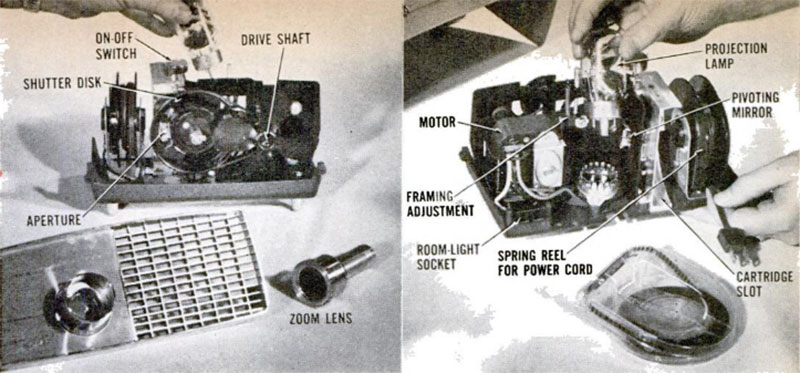
Breakdown of the Technicolor Instant Movie Projector 800
Image: March 1962 issue of Popular Science
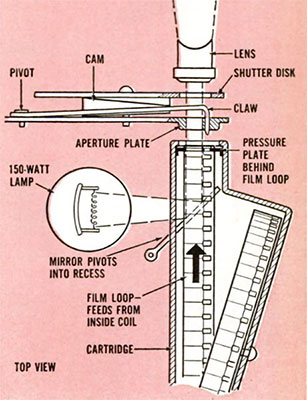 The feature by Alfred W. Lees says that Technicolor executives told him that only one in eight people who bought am 8mm film camera bought a projector to play the films they made. Perhaps they were hinting at a use for the range of Instant Movie projectors?
The feature by Alfred W. Lees says that Technicolor executives told him that only one in eight people who bought am 8mm film camera bought a projector to play the films they made. Perhaps they were hinting at a use for the range of Instant Movie projectors?
The feature mentions some of the advantages of the system. Keeping the film free from dirt and prying fingers and being able to repeat a small section of film, they give the example of being able to endlessly repeat a film of a golf shot until you are able to master it.
It also mentions some of the major shortcomings of the projectors, the films must be short enough to be put into the cartridges and only Technicolor was able to do that.
Technicolor originally marketed the projectors to businesses to enable their salesmen to demonstrate the company's products and services, and they advertised heavily throughout the 1960s in specialized trade magazines such as Business Screen.
Adverts for the Technicolor range of Instant Movie projectors from Business Screen and other magazines, 1962 - 1967
Techniolor's Instant Movie projectors and the Magi-cartridges seem to have captured the imagination of the business community almost as soon as they were introduced in 1962. The July 1963 issue of Business Screen magazine reported that the Kelvinator company had bought "Viewing Centers" for their dealerships which featured Technicolor's Instant Movie projector 800 and Magi-cartridges featuring four films made by Wilding Inc. about Kelvinator's "No-Frost" refrigerator, automatic washer, electric range, and "Fooderama" featuring their deluxe refrigerator and freezer. Kelvinator reported that during trials the "Viewing Center" converted 80% of viewers into sales.
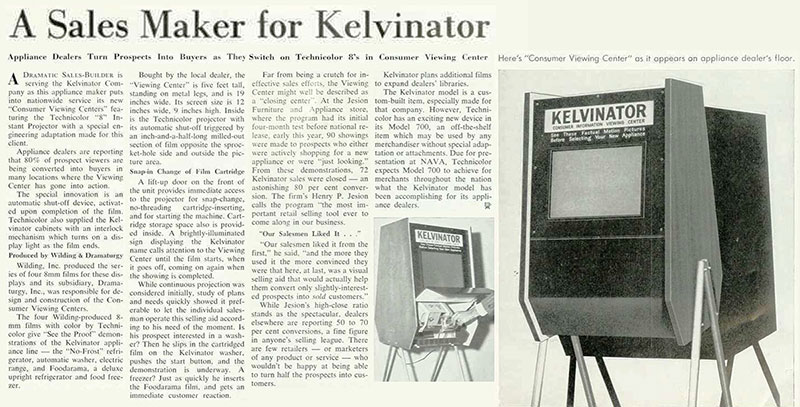
Kelvinator's Viewing Center
Click on the image for a larger image
Article recomposited from the original in the July 1963 issue of Business Screen magazine
Soon some of these companies were appealing to home users. "Weighing What You Want to Weigh" advertised their set of 9 Magi-cartridges along with a 510 projector. This advert appeared in the October 1966 issue of Listen magazine:
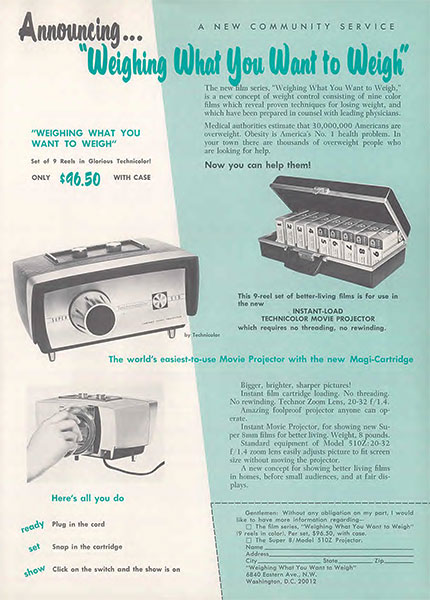
1966 "Weighing What You Want to Weigh" advert for 9 Magi-cartridges and a Technicolor 510 projector
Click on the image for a larger image
The full magazine can be seen on the Office of Archives, Statistics, and Research (ASTR) website
The projectors were easy to use, which is how "Weighing What You Want to Weigh" described them as "The world's easiest-to-use Movie Projector". The projectors really are easy to use; insert the cartridge and turn it on. The sprockets engage, the lamp lights and the motor starts.
Because of their ease of use, the Magi-cartridges found other uses. The DAV-MAR Film Company of Los Angeles put one of the Technicolor Instant Movie projectors along with an A.B.T. Manufacturing Company coin mechanism into a machine they called the Cine Fun Movie Machine. There were both an adult and a children's version of the machines and they were advertised in the 1963 editions of trade magazines such as Billboard and Cash Box.
Far from being a niche market, the Magi-cartridges enjoyed considerable success. The February 1969 issue of Business Screen magazine Technicolor announced that in addition to their own plant in Phoenix which loaded the cartridges they had licensed other companies to do the same. These companies were Super 8 City, Alexandria, Virginia; International Communication Films, Santa Ana, California; Bonded Services, New York, New York; Reela Film Labs, Miami, Florida; Audio-Graphics, Los Angeles, California; and Modern Trim, New York, New York.
The April 1969 of Business Screen magazine announced that Servis Equipment Company had been using Technicolor 500 projectors with C-106 carrying cases with rear-projection screen in 1,700 of their dealerships for the previous four years. Servis had made a dozen different films featuring their equipment for the Magi-cartridges. One of the dealers said that the instant movie projector was the most productive and least expensive salesman in his organization. Servis also used the projectors at various trade shows around the country.
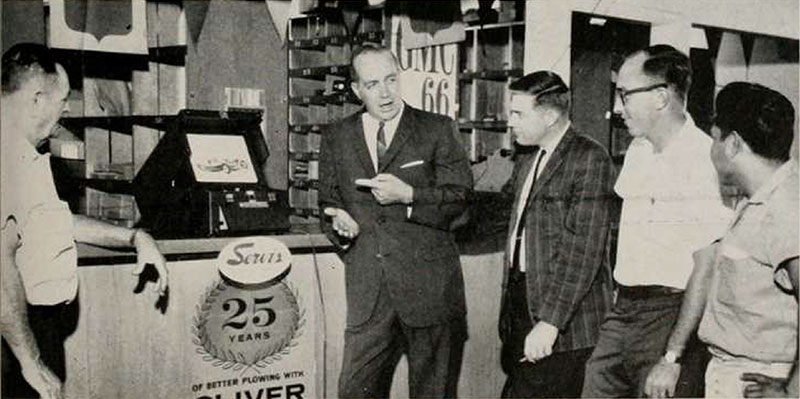
Servis executives with their Technicolor Instant Movie projector and rear-projection screen
Some companies saw the projectors as a means of demonstrating their products and Technicolor obliged by selling self-contained units with a small screen in the case such as the C107 which was designed for their 510, 800D and 810 projectors. Later, back projection units were available especially when the larger 8mm with sound film cartridges were made in the late 1960s.
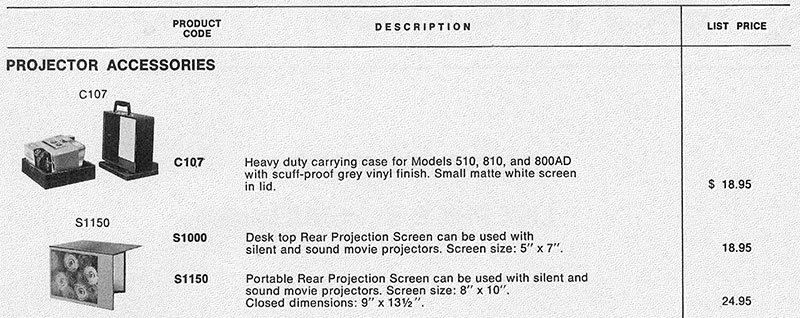
Portion of the Technicolor catalog from 1970
The full brochure can be seen on the Optical Toys website
The Magi-cartridges proved to be very popular with the pornographic film industry. First there were inventions like the Kinetoscope, Mutoscope and similar machines. With the invention of the Panoram, a sort of film loop jukebox in 1940, film loops drew the attention of pornographers. They soon developed the Solo-Vue and Hollywood Peep Show conversions for the Panoram which showed risqué films only one person at a time could view. Businessman George Atkinson is sometimes known as the father of home video rentals. His empire started in 1968 when he discovered the Technicolor Instant Movie projectors. That led to the formation of Home Theater Systems and the renting out of the projector, a screen and the Magi-cartridges for "adult entertainment."
There is nothing on the Technicolor Instant Movie projectors themselves to say whether they were designed for Standard 8mm Magi-cartridges or the Super 8 ones, but it is obvious which they were designed for by looking at the cartridge slot. Standard 8mm projectors have a "V" shaped bottomed slot, Super 8 ones have a groove to accept the ridge those cartridges have.
Technicolor stopped making Standard 8mm cartridge projectors in 1964. Starting in 1965, all the projectors were designed for Super 8 Magi-cartridges. The cartridges and projectors are not interchangeable.
Standard 8 vs Super 8 Magi-cartridges
The Standard 8 and Super 8 Magi-cartridges look very similar but they are not interchangeable. This is because of the different formats of the film.
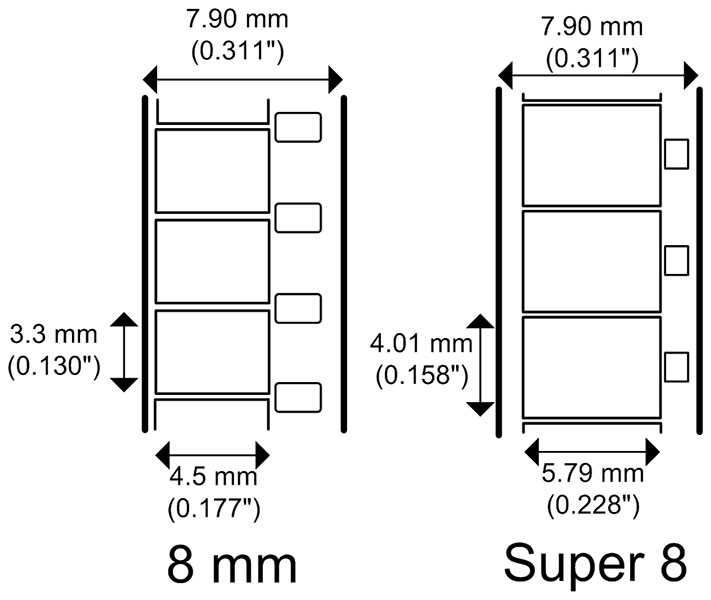
Comparison of 8mm and Super 8 film
Standard 8mm film was developed in 1932 by Eastman Kodak and had a picture area of 4.5mm x 3.3mm. Production ceased in the 1990s. Super 8 was developed in 1965 also by Eastman Kodak and has a picture area of 5.79mm x 4.01mm. It is still being made in 2022. Because of its slightly larger frame size, Super 8 tends to give better quality images.
To differentiate between the cartridges Technicolor made them slightly different. Standard 8 Magi-cartridges are made of clear plastic. Super 8 Magi-cartridges were made of transparent blue plastic, have a ridge running along the bottom of them, and were squared off on the loop end of the cartridge. Another clue is the fact that the Super 8 Magi-cardridges usually have "SUPER EIGHT" embossed om them.
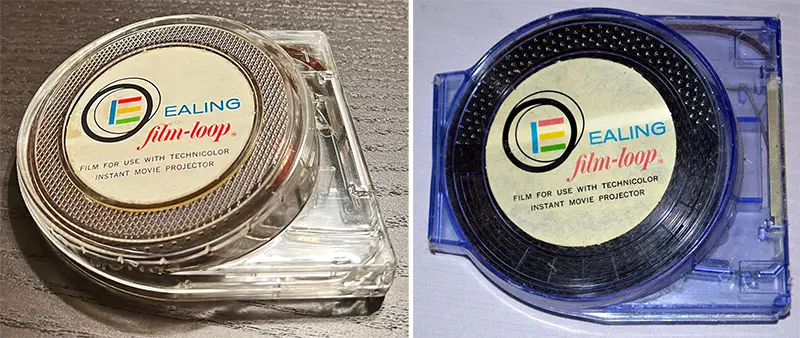
Comparison of Standard 8mm (left) and Super 8 (right) Magi-cartridges
Standard 8mm Magi-cartridge photo by Josh Ayers
A selection of Magi-cartridges:
The cartridges are not interchangeable. Standard 8mm cartridges will not fit into a projector made for Super 8 and vice versa. The same as any other Standard 8mm and Super 8 projectors, as the sprocket holes in the film are diffferent sizes and positioning, forcing the film into the wrong type of projector, even if were possible, will result in damage to the film.

Standard 8 vs Super 8 Magi-cartridge projector guide. Standard 8mm projector on the left, Super 8 on the right.
The Standard 8mm projectors have a flat V base to their film slots, Super 8 projectors have a groove for the ridge on the cartridges.
The Projectors
Technicolor made a range of Magi-cartridge projectors between 1962 and 1980. They all had a frame gate control and a levelling screw. Here is the data for the ones I know of:
| Model | Date | Cartridge Type | Retractable Cord | Pause Frame | Brightness Control | Accessory Socket | Lens | Lamp |
|---|---|---|---|---|---|---|---|---|
| 250 | 1963/64 | Standard | No | No | No | No | Technor Zoom f: 1.5 F: 9.5-15mm | DCL 120V 150W |
| 260 | 1965/66 | Super | No | Yes | No | No | Technor Zoom f: 1.5 F: 20-32mm | DJA (original) but also DCH/DJA/DFP replacement 120V 150W |
| 280 | 1968/69 | Super | No | Yes | No | No | Technor f: 1.1 F: 10mm | DJA (original) but also DCH/DJA/DFP replacement120V 150W |
| 500 | 1962/63 | Standard | No | No | No | No | Technor Zoom f: 1.5 F: 15-25mm | DJA (original) but also DCH/DJA/DFP replacement 120V 150W |
| 510 | 1965/66 | Super | No | No | No | No | Technor f/1.4 F:? | DJA (original) but also DCH/DJA/DFP replacement 120V 150W |
| 520 | 1965/66 | Super | No | DGB/DMD 30V 80W | ||||
| 580 | 1966/67 | Super | Yes | No | No | Yes | Technor Zoom f: 1.5 F: 15-25mm | DCL120V 150W |
| 800 | 1962/63 | Standard | Yes | No | No | Yes | Technor Zoom f: 1.4 F: 20-32mm | DCL or DJA but also DCH/DJA/DFP replacement 120V 150W |
| 800 Deluxe | 1962/63 | Standard | Yes | Yes | No | Yes | Technor Zoom f: 1.4 F: 20-32mm | DCL or DJA but also DCH/DJA/DFP replacement 120V 150W |
| 810 | 1966/67 | Super | No | Yes | Yes | No | Technor f: 1.1 F: 10mm | DCF 21V 150W |
| 820 | 1976/80 | Super | No | No | Yes | No | Technor f: 1.1 F: 10mm | ELE or EPF 30V 80W |
Some of the projectors say to use the DJA type of lamp only. In reality the DJA, DCH, or DFP type lamps can be used as they are equivalents. The Accessory Socket that appeared on the 800 and 580 models was for thing such as a table lamp. When the projector was turned on, the power to the whatever was plugged into the socket would be turned off.
It seems counter-intuitive but to turn the projectors on, the on/off button needs to turned counterclockwise.
Technicolor Instant Movie Projector 260
In 1966, Technicolor described the 260 projector as the export version of the 510 projector capable of operating with dual voltages of 110/120 volts and 240/250 volts 50-cycle supplies.
Technicolor Instant Movie Projector 280
The Technicolor Instant Movie Projector 280 was manufactured in 1968/69 and uses Super 8 Magi-cartridges.
Technicolor Instant Movie Projector 500
The Technicolor Instant Movie Projector 500 was manufactured in 1962/63 and uses Standard 8mm Magi-cartridges. In July 1963, Technicolor announced they had a wide-angle version of this projector, the 500WA. The new projector would fit into their C-106 rear-projection case which also had room for up to 8 Magi-cartridges.
Technicolor Instant Movie Projector 510
The Technicolor Instant Movie Projector 510 was manufactured in 1965/66 and uses Super 8 Magi-cartridges.
Technicolor Instant Movie Projector 580
The Technicolor Instant Movie Projector 580 was manufactured in 1966/67 and uses Super 8 Magi-cartridges.
Technicolor Instant Movie Projector 800
The Technicolor Instant Movie Projector 800 was manufactured in 1962/63 and uses Standard 8mm Magi-cartridges. In July 1963, Technicolor announced they had a wide-angle version of this projector, the 800WA. The new projector would fit into their C-106 rear-projection case which also had room for up to 8 Magi-cartridges.
Technicolor Instant Movie Projector 800 Deluxe
The Technicolor Instant Movie Projector 800 Deluxe was manufactured in 1963/64 and uses Standard 8mm Magi-cartridges. The 800 Deluxe differs from the standard 800 in that it has a still-frame feature and the lower fascia is chromed.
Technicolor Instant Movie Projector 810
The Technicolor Instant Movie Projector 810 was manufactured in 1966/67 and uses Standard 8mm Magi-cartridges. In their 1966 advertising, Technicolor described the 810 Deluxe projector as having a "Super Brilliant Light System" with a low-wattage lamp and a dual output transformer that allowed a choice of normal lamp brilliance with a 500% increase in lamp life or a 40% increase in brilliance with normal lamp life. That model also came with the still-picture feature. This model has the same features but there is nothing on the projector to indicate this is the Deluxe model.
Technicolor Instant Movie Projector 810 Deluxe
In their 1966 advertising, Technicolor described the 810 Deluxe projector as having a "Super Brilliant Light System" with a low-wattage lamp and a dual output transformer that allowed a choice of normal lamp brilliance with a 500% increase in lamp life or a 40% increase in brilliance with normal lamp life. This model also came with the still-picture feature.
Technicolor Instant Movie Projector Silent 820
The "Silent" in the name of this 1976/80 Super 8 Magi-cartridge projector refers to the fact it cannot play sound films not that the mechanism is silent. It is about as noisy as any of these old projectors. This model has a flat brown textured vinyl front instead of the curved silver front many of the Technicolor Instant Movie projectors used. The projector does not have a zoom lens and the body is made of plastic not steel.
Consumables
These projectors have very little in the way of consumables. The main one being the lamp and the other being the rubber drve belt bweeen the motor and film transport. Belts sometimes stretch or break. One of the best suppliers of replacements I have found is Turntable Needles.Projector lamps do not have an infinite life, most for these projectors are rated at just 15 hours of use. When these projectors were made a new lamp would cost between $5 and $6. A new one today could cost close to $100. The Australian Council of Film Societies (ACOFS) has a very useful guide to projector lamp substitutions. This can be used to find cheaper alternatives or alternatives if the original type of lamp is no longer available. Of course, you could always take a chance and buy another projector!
As with any projector lamp, it is recommended not to touch the lamp or reflector with bare fingers but to use gloves or a cloth instead. Grease from your fingers can cause uneven heating of the lamp and shorten its life.
Of the ones I have seen, as time went on the build quality went down a little. One of the worst failures is that the cam that controls the movement of the film claw was made of plastic and sometimes disintegrate. These cams were used on the 280 (1968/69) and 820 (1976/80), both Super 8, models. Knowing what I now know about these cams, I would stay away from both the 280 and 820 models.
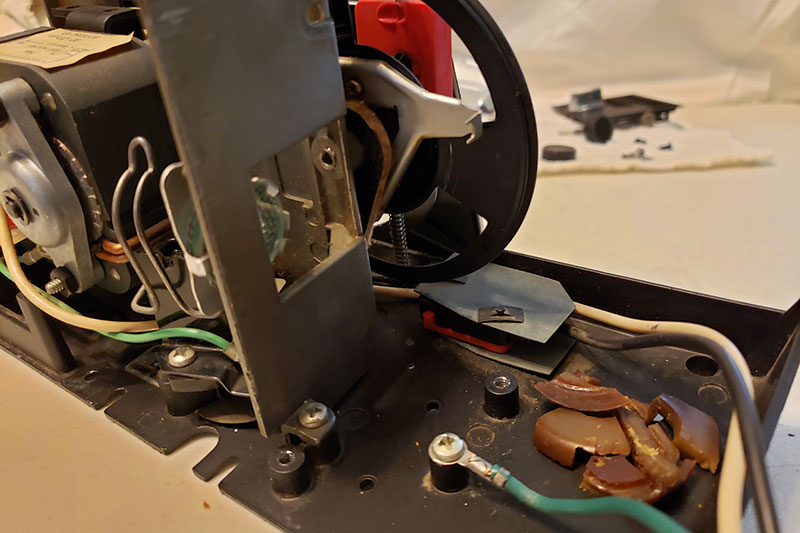
Broken film claw cam on a Technicolor Instant Movie projector 280
The cam should be on the pulley wheel behind the film claw
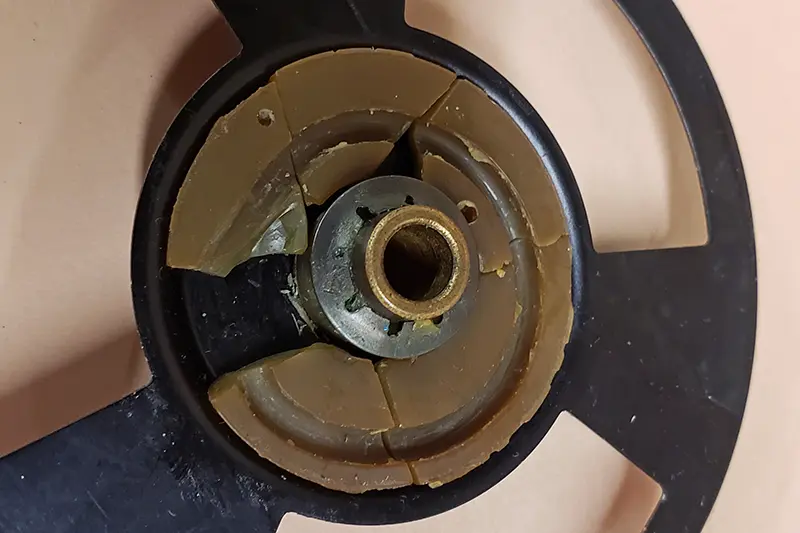
Broken film claw cam on a Technicolor Instant Movie Projector 280
Hopefully this piece may be able to be 3D-printed
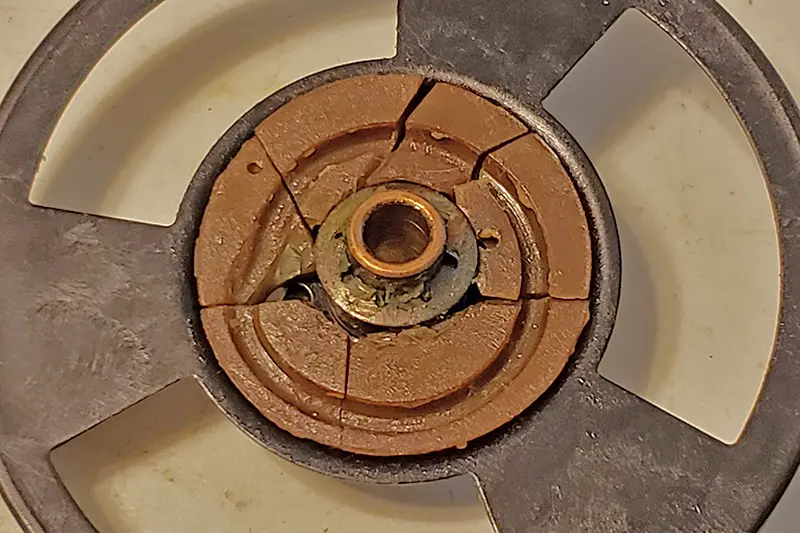
This piece is 1.5" in diameter across the top, and 3/16" thick. The center hole has a diameter of 17/32" The diameter across the bottom of the piece is 1/4" smaller than the top and is curved to meet the top diameter. The groove is 1/8" in width.
Now for the awkward part; the groove is not circular and varies in depth. Starting from the flat part of the groove which is 1/8" from the edge of the piece, and moving clockwise. The groove remains flat for 70° but at that point is !/4" from the edge. The groove continues clockwise for another 190°, gradually moving to 1/8" towards the edge of the piece. The groove reamins this distance from the edge until it rejoins the start of the area where it is flat.
Along this flat edge, the groove is 1/16" deep, but increases and decreases fairly steeply to 1/8" deep along the rest of the groove.
The odd shape of the groove is due to how it controls the film claw. The film claw has to move backwards and forwards to engage the film sprockets, move film a fixed distance and then release it to engage in the next set of sprockets.
This is Important!
If you get hold of one of these projectors and a Magi-cartridge to use in it, when you first test the projector take the lamp out first. This is because if the film transport doesn't work and the lamp is on, it gets so hot you only have a couple of seconds to turn the projector off and get the cartridge out before the film starts melting.
Disassembly
Disassembly of these projectors is not difficult, but as with the taking apart of anything, you just have to be a little careful. Before doing anything, make sure the projector is not plugged into the mains electricity. These pictures are from my disassembly of a Technicolor Instant Movie 580 projector but all the models I have seen are about the same.
Cleaning the Film Mechanism
When playing a film sometimes there is fluff and debris showing up as shadows on the projected image, especially around the edges. If these shadows are in the same place when showing different films then it is time to take a look at the projector mechanism and clean it. The following photos are from the cleaning of a Technicolor Instant Movie 510 projector but all the models I have seen are about the same.
For most of the cleaning inside these projectors I use good quality isopropanol (isopropyl alcohol) wipes. I use them for the lenses, mechanisms and bodies. Be careful when cleaning the lenses. For larger areas use bottled isopropanol and a lint-free cloth. You do not want to leave more lint inside the mechanism. If they have larger specks of dirt and grime on them, wipe them off with a small brush. You do not want to wipe them until these have been removed, you could scratch the lenses. Take a little care when cleaning the mechanisms. You do not want to push anything out of alignment or wipe grease from the other parts of the mechanism onto the film transport.
Frame Adjustment
Sometimes frame adjustment of the film is required. What is happening is that the film aperture gate does not line up properly with the film frame causing the bottom of one frame to be shown along with the top of another. All models of the Technicolor Instant Movie projectors were made with a frame adjustment knob on top of the machine next to the on/off knob.
The frame adjustment knob can be completely unscrewed from the projector and putting it back incorrectly can cause problems. The bottom of the knob has to sit correctly on a small plate on the aperture plate arm. If it does not then the film claw arm cannot work properly and it creates more friction on the shutter disk and that can cause the driving belt to slip which sometimes causing a squealing noise, or cause the belt come off the pulley wheels completely. It also makes the projector noisier than it should be. Worse still, it can cause the film claw to stop working at all which can cause the film to melt from the heat of the lamp.
Removing the Film Mechanism
Sometimes it may be necessary to remove the film mechanism. Doing that is easy, there are only 3 or 4, depending on projector model, Phillips screws holding it in place, but there is a problem. When the mechanism is removed there will be a piece of shaped spring steel left on the floor of the projector. The only thing holding this piece of steel in place is the fact it is jammed between the motor and lamp holder mounting and the film mechanism. There is no positive mechanism holding it in place and getting this back in position is quite a job but there are three methods of doing it.
The purpose of this piece of shaped spring steel is to provide a positive feel to turning the on/off knob. The projector will work without it, but the knob will feel "sloppy" and not very positive so it is best to put it back where it was. Depending on the projector model, on the left, looking at the rear of the projector, the piece either rests against the wall of the motor and lamp holder platform, or into a small groove. On the right, it fits into a notch in the cam at the bottom of the on/off shaft.
I found three methods of getting this piece back in place that work. The one that is easiest seems to vary from model to model as there are differences in the lamp holders, if it fits into a groove or not on the left side, and whether the projector has a self-winding cord mechanism on the right.
Method 1
Remove the film mechanism and place the piece in roughly the correct position. Pull on the shaft that holds the cam at the bottom of the film mechanism until it is proud of the position it normally occupies. It makes it easier to line up the cam with the piece so that it fits properly. The rest of the mechanism can then be pushed into place.
Method 2
Place the piece in position on the left side and when refitting the film mechanism slide it slightly to the left so the right side of the piece latches into the notch on the cam at the bottom of the film mechanism. Then tighten the screws holding the film mechanism in place being careful not to move it out of place.
Method 3
Tighten the film mechanism in place and using a pair of long-nose pliers and long thin screwdriver maneuver the piece until its left hand side latches into the notch on the cam at the bottom of the film mechanism. Using the long thin screwdriver push against the left-hand side of the piece until it clicks into place.
All three methods are fiddly and may require more than one attempt, but apart from taking the whole projector apart I do not see how else to put this piece back in its proper position.
Motor Mounting
Working on a 580 model projector I saw the film transport was not working properly. Taking the cover off, I saw that the motor was loose on its mountings. Replacing the 3/8" grommets on the mounting secured the motor properly and the film transport started working normally.
With the top cover of the projector off and looking at the rear of the projector, the motor is on the left. The motor has a shaft which drives a small pulley wheel and the projector fan. The motor is attached to the backing plate by three bolts. These bolts pass through a rubber grommet with a metal bushing. Over the years the rubber grommet may corrode or crack meaning the motor is no longer properly secured to the backing plate. To replace the grommets and bushings, it is easier to remove the front cover of the projector.
Self-Winding Cord Mechanism
I got hold of a Technicolor 800 projector. I have no idea where it had been stored, probably somewhere very warm, as the main electrical cord was falling apart and ruined. It was not possible to simply replace the cord where it joined the projector as this is one of the models that use a self-winding cord mechanism. Rather than just discard the mechanism I decided to try and repair it.
How Much?
There were thousands of the projectors and cartridges made between 1960 and 1980. They were very popular in schools and colleges to show short educational films. Any for sale now probably came from one of those.
When new and depending what lens was fitted, a Technicolor 510 would cost between $109.50 and $136.50. A Technicolor 810 would cost between $149.50 and $176.50.
It is always hard to price these things but today in 2022, the projectors should cost between $30 and $40. You can sometimes find them for less than $10. I have a Technicolor 800 that cost me $0.99. On average I have paid $23 (plus postage and tax which brings the average up to $40) for my projectors. You can pay more for a projector depending on its condition and whether it has the original box and instruction booklet.
Bear in mind that the projector lamps do not have an infinite life, most are rated at just 15 hours of use. When these projectors were made a new lamp would cost between $5 and $6. A new one today could cost close to $100. The Australian Council of Film Societies (ACOFS) has a very useful guide to projector lamp substitutions. This can be used to find cheaper alternatives or alternatives if the original type of lamp is no longer available. Of course, you could always take a chance and buy another projector!
I think that $5 to $7 for a standard, generic Magi-cartridge is a fair price but some specialist or rare subject cartridges sell for over $100.
Collectors often pay more for particular projector models or Magi-cartridges. In 2017, Christie's auctioned a Technicolor 800 projector that once belonged to Audrey Hepburn (1929 - 1993). It was sold for £4,375 ($5,312).
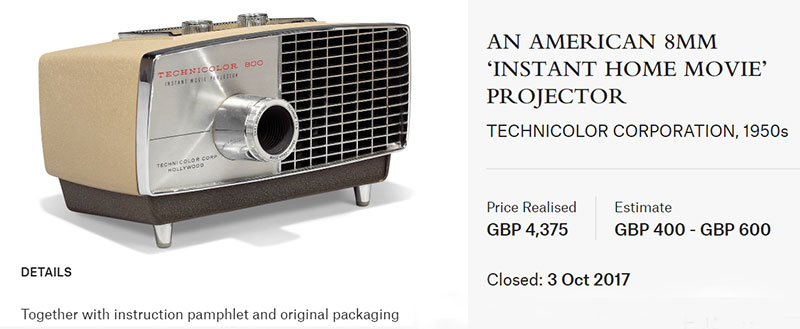
Christie's 2017 auction for a Technicolor 800 projector that once belonged to Audrey Hepburn
Other Magi-cartridge Projectors
I had thought Technicolor were the only company that made projectors for their Magi-cartridges but in October 2022, I came across a reference to the BUHL 880 Super 8 Filmloop Projector and those used Super 8 Magi-cartridges.
Papers and Lists
The Magi-cassettes and projectors became such a common feature in schools and colleges that scholarly papers were written about the technology and their usefulness in classes. School districts and institutions also produced lists of the resources available to them.
This is not a comprehensive list but some I have come across while writing this page.
Butler, Rebecca P. (January 1997). The Development and Demise of 8 MM Film Loops in America. VisionQuest: Journeys toward Visual Literacy. Selected Readings from the Annual Conference of the International Visual Literacy Association (28th, Cheyenne, Wyoming, October, 1996)
Chen, Yan & Butler, Rebecca P. (2013). The Technicolor 800 Instant Movie Projector. TechTrends. July/August 2013. 57(4). pp. 12-13.
Clark, R. C. Rowland. (1965). 8mm Loop Films—As a British Publisher Sees Them. Journal of the University Film Producers Association 17(2). pp. 15-18.
Simon Fraser University, Department of Physics, Lecture Demonstrations, 8mm Film Loops
Sources and Resources
Australian Council of Film Societies (ACOFS) has a very useful guide to projector lamp substitutions
Billboard - a weekly magazine dedicated to the music and jukebox industries published from November 1894 to the present. PDFs of the magazine are available from World Radio History
Billboard November 27, 1943 (World Radio History)
Billboard January 1, 1944 issue (World Radio History)
Billboard February 12, 1944 issue (World Radio History)
Billboard March 11, 1944 issue (World Radio History)
Billboard, January 12, 1963 issue (Google Books)
Billboard February 23, 1963 issue (World Radio History)
Billboard 1963/64 Coin Machine Directory (World Radio History)
Business Screen - a specialist magazine about Audio/Video for industrial and business film makers. The Hagley Digital Archives contains issues from 1938 to 1973.
Cash Box - a weekly magazine dedicated to the music and jukebox industries published from July 1942 to November 1996. It includes information on the jukeboxes. PDFs of the magazine are available from The Internet Archive, William and Mary University and World Radio History
Cash Box, February 16, 1963 issue (World Radio History)
Cash Box, April 6, 1963 issue (Internet Archive)
Christie's auction of a Technicolor 800 projector that belonged to Audrey Hepburn
Billboard November 27, 1943 issue (Google Books)
Danish Jukebox Archives - A history of the jukebox. This site also contains a list of films that were made for the AMI Rowe PhonoVue system
The Development and Demise of 8mm Film Loops in America - paper by Rebecca P. Butler. Published: January 1997
ERIC (Education Resources Information Center) / Institute of Education Sciences has a document called Lesson Guide for Captioned Films from 1972 that mention 8mm film loops. I do not know if these were Magi-cartridges or some other type.
Filmkorn Technicolor Projector Database
Museum of Obsolete Media - A page of the various older film cartridges
Museum of Obsolete Media - A page of Technicolor Magi-cartridges
Optical Toys has a brochure for Technicolor's 1970 range of Instant projectors
Optical Toys has a brochure for a Technicolor 260 projector
Panorams, Motels, and Pirates: The Origins of Adult Video by Peter Alilunas, University of California Press
Preservation Self-Assessment Program - History and preservation of old film by the University of Illinois at Urbana-Champaign.
Smutty Little Movies: The Creation and Regulation of Adult Video by Peter Alilunas, University of California Press
Technicolor Instant Movie Projector brochure
Technicolor patent for a cartridge motion picture projector
Technicolor patent for a motion picture film cartridge
Turntable Needles - One of the best suppliers of replacement drive belts I have found for these projectors
Urbanski Film - Suppliers of all sorts of spares and accessories for 8mm and 16mm projectors
Van Eck Video Services - Breakdown of a Technicolor 250 projector
YouTube Magi-cartridge Projectors Playlist
YouTube user amt253 - A collection of Magi-cartridge films
